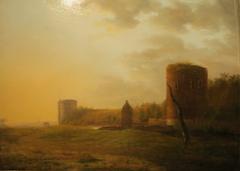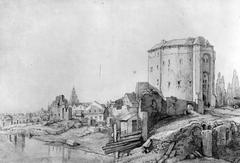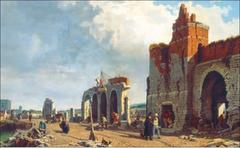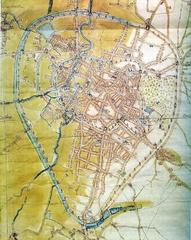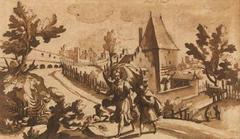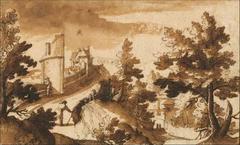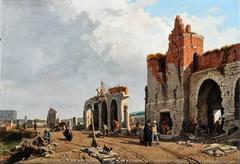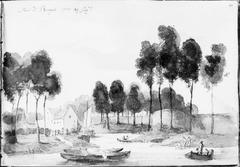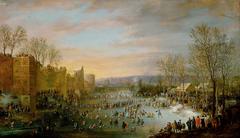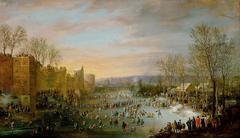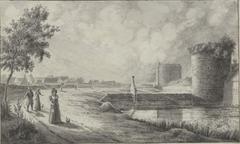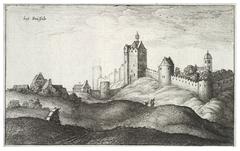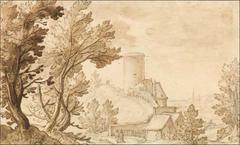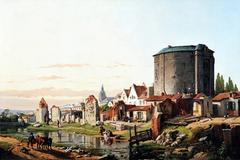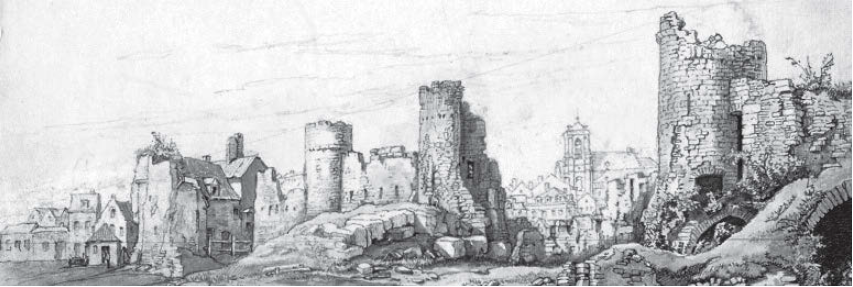
Brussels Fortifications: Visiting Hours, Tickets, and Historical Sites Guide
Date: 14/06/2025
Introduction to Brussels Fortifications
Brussels’ fortifications are enduring symbols of the city’s medieval roots, providing visitors with a vivid window into its strategic past and architectural evolution. Built from the early 13th century under Henry I, Duke of Brabant, the city’s first stone walls enclosed key sites such as Saint-Géry Island, the Grand Place, and the Coudenberg ducal palace (Wikipedia). These ramparts, marked by towers like the iconic Black Tower (Tour Noire), served both defensive and economic roles, regulating trade and ensuring security.
As Brussels’ influence grew, a larger second wall was constructed in the 14th century, spanning nearly 8 kilometers and featuring 72 towers and several monumental gates, including the Halle Gate (Porte de Hal). Though much was dismantled by the 19th century to allow urban expansion, significant remnants remain. Today, visitors can explore sites such as the Halle Gate museum, stroll along the Small Ring (Petite Ceinture) tracing the old walls, and discover towers like Tour Anneessens and Tour de Villers. Archaeological sites, including the Coudenberg Palace, further enrich the historical context (audiala.com; brussels.info).
This comprehensive guide details the history, architecture, visiting hours, ticketing, tours, accessibility, and nearby attractions related to Brussels’ fortifications. Whether your interest is medieval engineering, history, or panoramic city views, this resource will help you make the most of your visit (evendo.com; wiki-gateway.eudic.net).
Table of Contents
- Early Fortifications: The First Walls of Brussels
- The Second Walls: Expansion and Modernization
- Surviving Remnants and Urban Transformation
- Visiting Brussels’ Fortifications: Practical Information
- Medieval Defensive Architecture
- Tickets & Admission
- Guided Tours
- Nearby Attractions
- Urban Integration & Adaptive Reuse
- Symbolism, Community, & Cultural Engagement
- Heritage Management & Preservation
- Photographic and Educational Opportunities
- Remnants: First & Second Walls
- Archaeological Sites
- Visitor Tips
- Interactive Maps & Visuals
- FAQ
- Mapping the Fortifications
- Related Articles & Resources
- Call to Action
- Halle Gate: In-Depth Visiting Guide
Early Fortifications: The First Walls of Brussels
Construction & Purpose
The first city walls (French: première enceinte, Dutch: eerste stadsomwalling) were built in the early 1200s, forming an oval enclosure of about 4 kilometers and covering 80 hectares (audiala.com). These ramparts protected the city from attack and controlled the flow of goods and people (wiki-gateway.eudic.net). Key sites inside included Saint-Géry Island, the Grand Place, and the first port on the Senne River.
Architectural Features
Typical for the medieval period, these stone walls had towers and fortified gates. The Black Tower (Tour Noire) near St. Catherine’s Church stands as one of the few surviving structures (audiala.com). Its preservation owes much to its adaptation for civilian use, including as a tavern in the 16th century.
Decline & Dismantling
By the late 14th century, expansion beyond the first walls rendered them obsolete (Wikipedia). They were gradually dismantled from the 16th to 18th centuries, with only scattered towers and wall fragments, like the Black Tower and Tour Anneessens, visible today.
The Second Walls: Expansion and Modernization
Motivation & Construction
The second walls (French: seconde enceinte, Dutch: tweede stadsomwalling) were constructed after 1356, following rapid urban growth and military defeats (Wikipedia). Stretching nearly 8 kilometers, they doubled the city’s protected area.
Gates & Layout
These fortifications boasted 72 towers and at least seven major gates, including Laeken, Flanders, Anderlecht, Halle, Namur, Leuven, and Schaerbeek. The Canal Gate was added in the 16th century to regulate canal traffic (wiki-gateway.eudic.net). Defensive moats and earthworks further strengthened the perimeter.
Adaptation to Warfare
With the rise of gunpowder, the walls were upgraded in the 16th–17th centuries with bastions and ravelins. The Fort of Monterey (1672–1675) exemplifies these modifications, but even fortified, the city succumbed to the 1695 bombardment and 1746 occupation (wiki-gateway.eudic.net).
Surviving Remnants and Urban Transformation
By the 19th century, Brussels’ walls were obsolete and hindered urban growth. Their demolition, particularly after Belgian independence in 1830, made way for the Small Ring (Petite Ceinture), a series of boulevards encircling the historic city core (Wikipedia). Today, remnants include the Halle Gate, Black Tower, Tour Anneessens, Tour de Villers, and customs houses at former gates (audiala.com).
Visiting Brussels’ Fortifications: Practical Information
Halle Gate Museum
- Hours: Tuesday–Sunday, 10:00–17:00 (last entry 16:30); closed Mondays.
- Tickets: Adults €6, reduced €4, children under 12 free. Tickets via official site or onsite.
- Accessibility: Wheelchair accessible with assistance; upper floors via stairs.
- Tours: Available on weekends and by booking (brussels.info).
Black Tower
- Hours: Exterior view only, accessible at all times; interior open only for special events.
- Tickets: Free; viewable from Rue Sainte-Catherine.
Tour Anneessens & Tour de Villers
- Tour Anneessens: 24/7 street view; located near Sablon.
- Tour de Villers: Always visible from Rue de Villers near Place de Dinant.
- Tickets: Free; exterior view only.
Additional Sites & Accessibility
- Hôtel des Monnaies Metro Station: Medieval wall fragment on display during metro hours; standard fare applies.
- Coudenberg Palace: Tuesday–Sunday, 10:00–17:00; adults €8, reduced €5; partial wheelchair access (Coudenberg Palace site).
- Bruxella 1238: Tuesday–Sunday, 10:00–18:00; adults €5, reduced €3; children under 12 free (Bruxella 1238 website).
- Cathedral of Saints Michael and Gudula: Daily, 9:30–17:00; free entry.
Medieval Defensive Architecture
Brussels’ walls represent medieval urban planning and defense. The robust Stadsmuur and Villerstoren, constructed with thick limestone and brick, feature arrow slits, crenellations, and machicolations. The Halle Gate, dating from 1381, is the only surviving city gate and an architectural icon of Gothic military design (evendo.com; brussels.info).
Tickets & Admission
- Stadsmuur & Villerstoren: Free outdoor access.
- Halle Gate: €6–€8 adults; discounts for children, students, seniors, and Brussels Card holders.
- Coudenberg Palace & Bruxella 1238: €5–€8; reduced rates for children and seniors.
- Online/onsite purchase available.
Guided Tours
Guided tours are available for the Halle Gate and Coudenberg Palace, often led by local historians. Tour schedules vary, and group bookings are possible. Check with visit.brussels or local visitor centers.
Nearby Attractions
Combine your fortifications visit with:
- Grand Place: Brussels’ UNESCO-listed central square.
- Royal Museums of Fine Arts: Art collections near the historic center.
- Marolles & Sablon: Vibrant neighborhoods with markets, cafes, and antique shops.
- Museum of the City of Brussels and the Cathedral of Saints Michael and Gudula.
Urban Integration & Adaptive Reuse
The Small Ring boulevards trace the path of the second wall, and modern buildings coexist with medieval remnants. The Halle Gate is now a museum, and many towers serve as open-air monuments (evendo.com; visit.brussels).
Symbolism, Community, & Cultural Engagement
The fortifications are powerful emblems of Brussels’ resilience and autonomy. The Halle Gate and other remnants are focal points for festivals, historical reenactments (like the Ommegang), and educational programs, reinforcing the city’s collective memory (karlobag.eu; brussels.info).
Heritage Management & Preservation
Local heritage authorities oversee conservation, balancing preservation with urban demands. Restoration projects stabilize masonry, improve accessibility, and add interpretive signage. Community engagement includes volunteer programs and heritage events (evendo.com).
Photographic and Educational Opportunities
Photographers and artists will find inspiration in the contrast between ancient stonework and contemporary Brussels. Educational materials, virtual tours, and interactive maps are available via visit.brussels and the Audiala app.
Remnants: First & Second Walls
- Tour Anneessens: Best-preserved 13th-century tower; boulevard de l’Empereur.
- Tour de Villers: Rue de Villers, near Place de Dinant.
- Tour Noire (Black Tower): Rue Sainte-Catherine.
- Porte de Hal: Boulevard du Midi 150; the most prominent 14th-century gate.
- Hôtel des Monnaies Metro: Medieval wall segment inside the station.
- Petite Ceinture: Modern ring road tracing the second wall’s footprint.
Archaeological Sites
- Coudenberg Palace: Underground medieval palace remains.
- Bruxella 1238: Ruins of a 13th-century monastery beneath the former Stock Exchange.
- Cathedral of Saints Michael and Gudula: Linked to city’s defensive history.
Visitor Tips
- Accessibility: Most major sites are accessible; check for stairs at towers.
- Tickets: Buy online for Halle Gate and Coudenberg Palace to save time.
- Events: The Ommegang festival and Urban Archaeology Days offer unique access.
- Routes: Walking or cycling the Small Ring reveals fortification traces.
Interactive Maps & Visuals
- Interactive maps and virtual tours are available at visit.brussels and via the Audiala app.
- Suggested alt tags for visuals: “Brussels fortifications visiting hours,” “Halle Gate tickets,” “Brussels historical sites map.”
FAQ
Q: What are Halle Gate’s visiting hours?
A: Tuesday–Sunday, 10:00–17:00 (last entry 16:30), closed Mondays.
Q: How much are tickets?
A: Halle Gate: €6–€8 adults, discounts for eligible groups. Outdoor sites are free.
Q: Are the fortifications accessible?
A: Halle Gate and Coudenberg Palace offer accessible facilities; some towers have stairs.
Q: Can I join a guided tour?
A: Yes, at major sites. Book in advance for group tours.
Q: What’s the best way to explore the fortifications?
A: Combine walking tours with museum visits; follow the Small Ring and marked routes.
Mapping the Fortifications: Key Locations
- Porte de Hal: Boulevard du Midi 150 (Google Maps)
- Tour Anneessens: Boulevard de l’Empereur
- Tour de Villers: Rue de Villers
- Tour Noire: Rue Sainte-Catherine
- Coudenberg Palace: Place des Palais 7
- Bruxella 1238: Rue de la Bourse 1
Related Articles & Resources
- Brussels’ Medieval Architecture
- Walking Tours in Brussels
- World Wild Schooling’s Brussels Guide
- Visit Brussels Must-See Attractions
Call to Action
Ready to explore Brussels’ fortified history? Download the Audiala app for audio guides and interactive tours. Follow our social media channels for updates on events, practical tips, and heritage news.
Halle Gate Visiting Hours, Tickets & Tips
Location: Boulevard du Midi 150, 1000 Brussels
Hours: Tuesday–Sunday, 10:00–18:00 (last entry 17:00); closed Mondays.
Tickets: Adults ~€8; discounts for students, seniors, children; free with Brussels Card.
Accessibility: Main exhibitions accessible; tower and some upper floors by stairs.
More info: Halle Gate Museum website
Highlights
- Exhibitions: Medieval weaponry, artifacts, and models of city defenses.
- Tower Climb: Panoramic views of Brussels from the top.
- Guided Tours: Multilingual options; book in advance.
- Events: Medieval fairs, reenactments, and workshops—check events calendar.
- Facilities: Restrooms, gift shop; many cafes nearby.
How to get there: Metro Porte de Hal/Hallepoort (lines 2, 6), tram, or short walk from Grand Place.
Summary and Visitor Tips
Brussels’ fortifications are tangible links to its medieval origins and ongoing cultural life. The Halle Gate, Black Tower, Tour Anneessens, and archaeological sites like Coudenberg Palace invite visitors to step into history. Check official sources for up-to-date hours and ticketing, consider a guided tour, and use digital resources for an enriched experience (Wikipedia; audiala.com; evendo.com; brussels.info).
References
- Fortifications of Brussels – Wikipedia
- Audiala – Brussels Black Tower
- Stadsmuur en Villerstoren – Evendo
- Museums in Brussels – Brussels.info
- Halle Gate Museum – Official Site
- Fortifications of Brussels – Wiki-Gateway
- Visit Brussels – Saint-Gilles
- KarloBag – Diversity of Tourism in Belgium
Images and interactive maps are recommended for inclusion. Use SEO-optimized alt text such as “Porte de Hal visiting hours,” “Tour Anneessens historical site,” and “Brussels medieval fortifications.”

